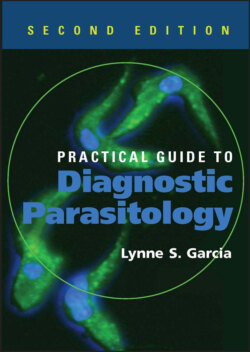Читать книгу Practical Guide to Diagnostic Parasitology - Lynne Shore Garcia - Страница 46
На сайте Литреса книга снята с продажи.
Conventional Microscopy
ОглавлениеOften, when the diagnosis of malaria is considered, only a single blood specimen is submitted to the laboratory for examination; however, single films or specimens cannot be relied upon to exclude the diagnosis, especially when partial prophylactic medication or therapy is used. Partial use of antimalarial agents may be responsible for reducing the numbers of organisms in the peripheral blood and lead to a blood smear that contains few organisms and a conclusion that reflects a low parasitemia when in fact serious disease is present. Patients with a relapsing case or an early primary case can also have few organisms in the blood smear. It is recommended that both thick and thin blood films be prepared immediately, and at least 300 oil immersion fields should be examined on both films before a negative report is issued. Since one set of negative smears does not rule out malaria, additional blood specimens should be examined over a 36-h period. Although Giemsa stain has been recommended for all parasitic blood work, the organisms can also be seen if other blood stains, such as Wright’s stain or any of the rapid blood stains, are used. Blood collected with the use of EDTA anticoagulant is preferred over heparin; however, if the blood remains in the tube for approximately an hour or more, true stippling might not be visible within the infected erythrocytes (e.g., those infected with P. vivax). Using EDTA, if blood is held for more than 2 h prior to blood film preparation, several artifacts may be seen; after 4 to 6 h, some of the parasites will be lost. During the time when the parasites are in the tube of blood, they continue to grow and change according to the life cycle for that species. Also, when using anticoagulants, it is important to remember that the proper ratio between blood and anticoagulant is necessary for good organism morphology—fill the tube with blood. Both thick and thin blood films should be prepared immediately after receipt of the blood. If the specimen is sent to a reference laboratory, both the thick and thin blood films, as well as the tube of blood (room temperature), should be sent. Since this test is always considered a STAT request, it is also important to know what turnaround times are available from the reference laboratory.
All requests for malaria diagnosis are considered STAT requests, and specimens should be collected, processed, examined, and reported accordingly. Although other diagnostic tests can be ordered, any request for examination of blood films should include a possible diagnosis of malaria; thus, these requests are always considered STAT. Not only should the blood collection be considered STAT, but also the processing and examination of both thick and thin blood films should be performed immediately on receipt of the blood. Often immunologically naive individuals with no prior exposure to malaria can present to the emergency room or clinic with symptoms such as fever and malaise and a relevant travel history to an area of the world where malaria is endemic. These patients can have very vague symptoms, but they have the potential to become very ill with malaria, even with a low parasitemia (0.0005% to 0.1%).
